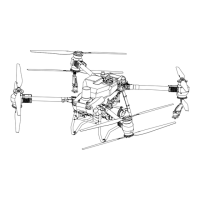AGRAS T50/T25
Unmanned Aircraft Flight Manual
72
©
2023 DJI All Rights Reserved.
Conditioning Batteries
If the battery is not used for an extended period, the battery life may be reduced.
Fully charge and discharge the battery at least once every three months to ensure the
performance of the battery.
If a battery has not been charged or discharged for five months or more, the battery
will no longer be covered by the warranty.
Replacing Batteries
The battery should not be used again if any accident occurs. Users should replace the battery
immediately. See details below.
1. DO NOT use swollen, leaking, or damaged batteries.
2. DO NOT use a battery that has been dropped.
3. If the battery falls into water while inserted in an aircraft during flight, take it out
immediately, and put it in a safe and open area. DO NOT use the battery again.
4. If the battery cannot be discharged completely, replace the battery and contact a
professional battery recycle company for assistance on disposal.
Maintenance Program
Operator Performing List
1. Clean all parts of the aircraft at the end of each day of spraying after the aircraft returns
to a normal temperature. DO NOT clean the aircraft immediately after operations are
completed.
a. Fill the spray tank with clean water or soapy water and spray the water through the
sprinklers until the tank is empty. Repeat the step two more times.
b. Remove the spray tank strainer and sprinklers to clean them and clear any blockage.
Afterwards, immerse them in clean water for 12 hours.
c. Make sure that the aircraft structure is completely connected so that it can be washed
directly with water. It is recommended to use a spray washer filled with water to clean the
aircraft body and wipe with a soft brush or wet cloth before removing water residue with
a dry cloth.
d. If there is dust or pesticide liquid on the motors, propellers, or heat sinks, wipe them with
a wet cloth before cleaning the remaining water residue with a dry cloth.
e. Store the cleaned aircraft in a dry environment.
2. Wipe the surface and screen of the remote controller with a clean wet cloth that has been
wrung out with water daily after operations.
3. Inspect the aircraft every 100 flights or after flying for over 20 hours:
a. Check for and replace worn propellers.
b. Check for loose propellers. Replace propellers and propeller washers if needed.
c. Check for aging plastic or rubber parts.

